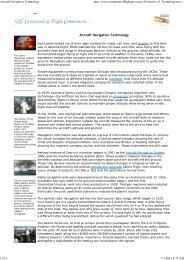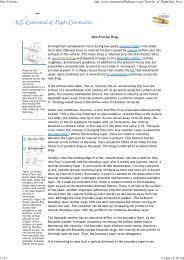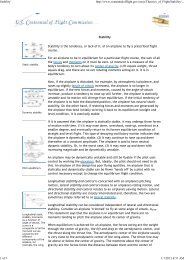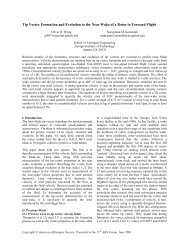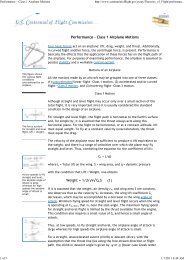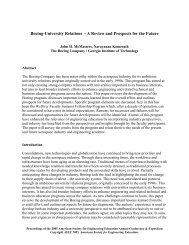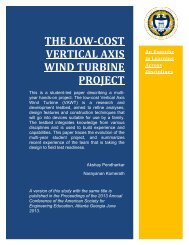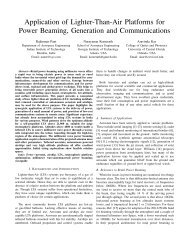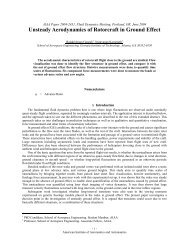Optimization of a Vertical Axis Micro Wind Turbine for Low Tip ...
Optimization of a Vertical Axis Micro Wind Turbine for Low Tip ...
Optimization of a Vertical Axis Micro Wind Turbine for Low Tip ...
You also want an ePaper? Increase the reach of your titles
YUMPU automatically turns print PDFs into web optimized ePapers that Google loves.
I. Introduction<strong>Vertical</strong> axis wind turbines <strong>of</strong>fer a safe, inexpensive solution <strong>for</strong> <strong>of</strong>f-grid power generation in remoteareas. They can be located closer to the ground than horizontal axis machines. The rotational speeds andblade stresses are much lower than those on horizontal axis machines <strong>of</strong> the same power level, and henceblade technology can be brought down to levels that are compatible with construction and maintenanceusing locally available skills and materials. However, the VAWT is a complex machine with low efficiency,operating with unsteady aerodynamics and strong interactions between the flows around its components.VAWT operating characteristics are also highly complex. These machines cannot start themselves exceptthrough drag-based devices and cannot reach optimal operating speeds without external drives. Their powergeneration depends very strongly on the tip speed ratio, the ratio <strong>of</strong> blade speed to wind speed. Optimaloperation typically occurs at tip speed ratios between 3 and 5, meaning that the turbine speed must exceedwind speed by a large factor. To reach such speeds, a motor is typically used. For optimal operation, thecontrol system must then reverse the direction <strong>of</strong> power flow from motor to generator mode and keep themachine in a viable tip speed ratio regime. To make the device suitable <strong>for</strong> its intended role, these operationsmust become routine and adapt to the local environment. Such a state <strong>of</strong> technical development requires athorough understanding <strong>of</strong> all aspects <strong>of</strong> machine characteristics.The objective <strong>of</strong> the work described in this paper is to develop a VAWT testbed that can be used toenable prediction and optimization <strong>of</strong> such machines. Progress towards this objective has taken a meanderingpath. 1 A constraint imposed at the beginning was that all rotating parts (which are typically very expensiveto buy in remote locations) were to be obtained exclusively from bicycles, or at most, motorcycles. Both<strong>of</strong> these vehicles are freely available in most parts <strong>of</strong> the world, and their operation and maintenance arefamiliar to local people—even children—<strong>of</strong> all socioeconomic levels. Initial designs studied the possibility<strong>of</strong> using blades that were highly flexible and had very simple geometry. <strong>Vertical</strong> window blind slats wereused as blades, their camber providing some slight bending stiffness. Given that the blades were to beinexpensive, we investigated the possibility <strong>of</strong> using double blades arranged in biplane fashion as a way toincrease power output without substantially increasing the solidity or the number <strong>of</strong> arms. An aluminumdouble blade attachment was invented to hold the cambered, thin-plate blinds at the top and bottom. Aversion with four double blades was initially tested in a low-speed wind tunnel but quickly changed to threedouble blades to avoid sub-harmonic swaying <strong>of</strong> the mast. Both the three-bladed and four-bladed versionsexhibited a torque well in the azimuth range between 90 ◦ and 180 ◦ (where the blade was advancing into thewind) due to blade stall. This prevented self-starting even when Savonius-type drag tubes were added. Thisproblem was resolved by adding a static guide vane in this azimuth range to redirect the wind. A 1 m × 1 mmodel reached over 250 rpm in wind speeds up to 45 ft/s at the exit <strong>of</strong> an open-return low speed windtunnel. Centrifugal bowing <strong>of</strong> the blades was controlled by tying the blades to the mast in the middle usingnylon threads. A 2 m × 2 m version was then developed using the same technology <strong>of</strong> vertical blinds andtested in the settling section <strong>of</strong> a closed-return tunnel, where there were still strong fluctuations in the winddownstream <strong>of</strong> the tunnel fan blades. This experiment failed completely, as the blinds proved to have toolittle torsional stiffness and fluttered out <strong>of</strong> control as the machine began to turn, driven by the drag tubes.In both this and the 1 m × 1 m version, the peak speed reached actually increased when the lift-generatingblades were removed and the machine was operated with only Savonius drag tubes. The upper and lowerarm assemblies were then rotated 30 ◦ with respect to each other to slant the blades and thus distribute thepower generation more evenly. The blades were built with low Reynolds number airfoil sections, wooden ribs,a PVC pipe as the main spar, and PVC ro<strong>of</strong>-flashing sheets wrapped over the templates and stapled at thetrailing edge to <strong>for</strong>m the torsion box and skin. The attachments were PVC tube T-joints, thereby keepingthe construction technology and parts availability at the desired levels. This version generated mechanicalpower levels <strong>of</strong> over 60 W in strong winds. A larger model 6 ft in diameter was then developed, this timeintended to survive high wind speeds in a 2.54 m × 2.74 m wind tunnel. This is ultimately intended <strong>for</strong> useby coastal communities and designed to survive winter winds. Accordingly the construction used heaviersteel parts and blades constructed with wood, high-density foam, and fiberglass/resin skins.2 <strong>of</strong> 11American Institute <strong>of</strong> Aeronautics and Astronautics



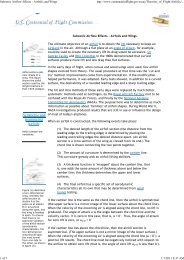

![p density of fluid, kg/m3 [Greek letter rho] V mean velocity of fluid, m ...](https://img.yumpu.com/50595898/1/184x260/p-density-of-fluid-kg-m3-greek-letter-rho-v-mean-velocity-of-fluid-m-.jpg?quality=85)
